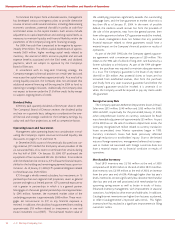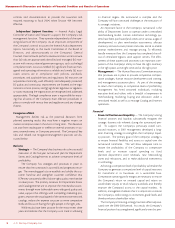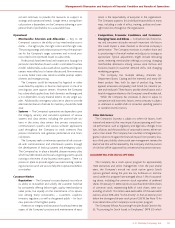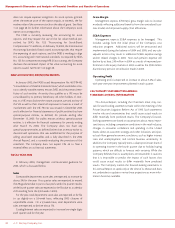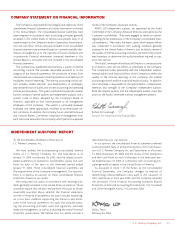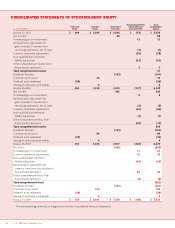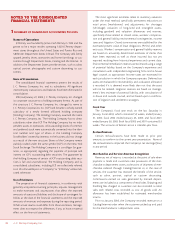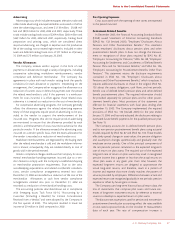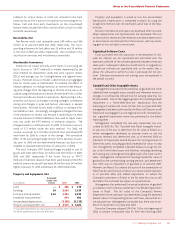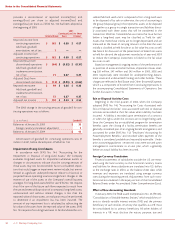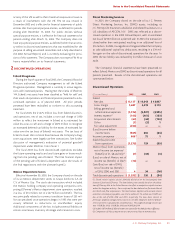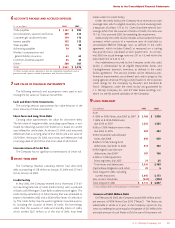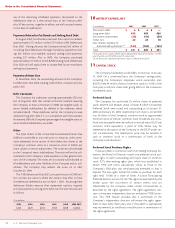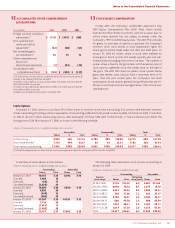JCPenney 2003 Annual Report Download - page 28
Download and view the complete annual report
Please find page 28 of the 2003 JCPenney annual report below. You can navigate through the pages in the report by either clicking on the pages listed below, or by using the keyword search tool below to find specific information within the annual report.
J. C. Penney Company, Inc.26
NOTES TO THE CONSOLIDATED
FINANCIAL STATEMENTS
1SUMMARY OF SIGNIFICANT ACCOUNTING POLICIES
Nature of Operations
JCPenney was founded by James Cash Penney in 1902 and has
grown to be a major retailer, operating 1,020 JCPenney depart-
ment stores throughout the United States and Puerto Rico and
58 Renner Department Stores in Brazil. The Company sells family
apparel, jewelry, shoes, accessories and home furnishings to cus-
tomers through Department Stores, Catalog and the Internet. In
addition, the Department Stores provide services, such as salon,
optical, portrait photography and custom decorating, to cus-
tomers.
Basis of Presentation
The consolidated financial statements present the results of
J. C. Penney Company, Inc. and its subsidiaries. All significant
intercompany transactions and balances have been eliminated in
consolidation.
Effective January 27, 2002, J. C. Penney Company, Inc. changed
its corporate structure to a holding company format. As part of
this structure, J. C. Penney Company, Inc. changed its name to
J. C. Penney Corporation, Inc. (JCP) and became a wholly owned
subsidiary of a newly formed affiliated holding company
(Holding Company). The Holding Company assumed the name
J. C. Penney Company, Inc. The Holding Company has no direct
subsidiaries other than JCP. The Holding Company has no inde-
pendent assets or operations. All outstanding shares of common
and preferred stock were automatically converted into the iden-
tical number and type of shares in the Holding Company.
Stockholders’ ownership interests in the business did not change
as a result of the new structure. Shares of the Company remain
publicly traded under the same symbol (JCP) on the New York
Stock Exchange. The Holding Company is a co-obligor (or guar-
antor, as appropriate) regarding the payment of principal and
interest on JCP’s outstanding debt securities. The guarantee by
the Holding Company of certain of JCP’s outstanding debt secu-
rities is full and unconditional. The Holding Company and its
consolidated subsidiaries, including JCP, are collectively referred
to in this Annual Report as “Company” or “JCPenney,” unless indi-
cated otherwise.
Use of Estimates
The preparation of financial statements, in conformity with
generally accepted accounting principles, requires management
to make estimates and assumptions that affect the reported
amounts of assets and liabilities and disclosure of contingent lia-
bilities at the date of the financial statements and the reported
amounts of revenues and expenses during the reporting period.
While actual results could differ from these estimates, manage-
ment does not expect the differences, if any, to have a material
effect on the financial statements.
The most significant estimates relate to inventory valuation
under the retail method, specifically permanent reductions to
retail prices (markdowns) and adjustments for shortages
(shrinkage); valuation of long-lived and intangible assets,
including goodwill; and valuation allowances and reserves,
specifically those related to closed stores, workers’ compensa-
tion and general liability, environmental contingencies, income
taxes and litigation. Closed store reserves are established for the
estimated present value of lease obligations (PVOL) and other
exit costs. Workers’ compensation and general liability reserves
are based on actuarially determined estimates of claims that
have been reported, as well as those incurred but not yet
reported resulting from historical experience and current data.
Environmental remediation reserves are estimated using a range
of potential liability, based on the Company’s experience and
consultation with independent engineering firms and in-house
legal counsel, as appropriate. Income taxes are estimated for
each jurisdiction in which the Company operates. Deferred tax
assets are evaluated for recoverability, and a valuation allowance
is recorded if it is deemed more likely than not that the asset
will not be realized. Litigation reserves are based on manage-
ment’s best estimate of potential liability, with consultation of
in-house and outside counsel, and are based upon a combina-
tion of litigation and settlement strategies.
Fiscal Year
The Company’s fiscal year ends on the last Saturday in
January. Fiscal 2003, which contained 53 weeks, ended January
31, 2004; fiscal 2002 ended January 25, 2003; and fiscal 2001
ended January 26, 2002. Both fiscal 2002 and 2001 contained 52
weeks. The accounts of Renner are on a calendar-year basis.
Reclassifications
Certain reclassifications have been made to prior year
amounts to conform to the current year presentation. None of
the reclassifications impacted the Company’s net earnings/(loss)
in any period.
Merchandise and Services Revenue Recognition
Revenue, net of returns, is recorded at the point of sale when
payment is made and customers take possession of the mer-
chandise in department stores, at the point of shipment of mer-
chandise ordered through Catalog/Internet or, in the case of
services, the customer has received the benefit of the service,
such as salon, portrait, optical or custom decorating.
Commissions earned on sales generated by licensed depart-
ments are included as a component of retail sales. Shipping and
handling fees charged to customers are also recorded as retail
sales with related costs recorded as cost of goods sold. An
allowance has been established for estimated merchandise
returns.
Prior to January 2002, the Company recorded revenue on a
Catalog/Internet order when the customer picked up and paid
for the merchandise at a department store.


